Range 2,656 km Wingspan 23 m Cruise speed 829 km/h | Top speed 876 km/h Length 33 m Engine type General Electric CF34 | |
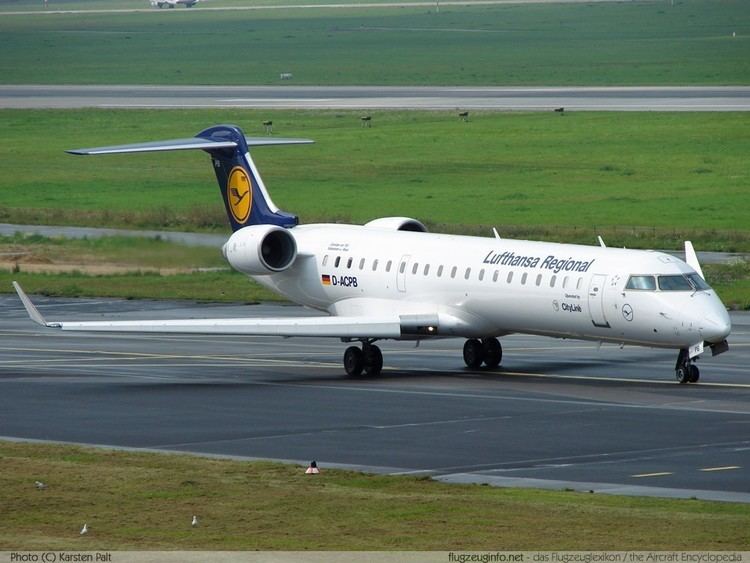 | ||
Unit cost 24,000,000–39,700,000 USD (2006) | ||
Crj900 nextgen aircraft on a special mission chase plane for cs300 aircraft s first flight
The Bombardier CRJ700, CRJ900, and CRJ1000 are regional airliners manufactured by Bombardier and based on the CRJ200. Final assembly of the aircraft is at Montréal-Mirabel International Airport in Mirabel, Quebec, outside Montreal, Quebec, Canada.
Contents
- Crj900 nextgen aircraft on a special mission chase plane for cs300 aircraft s first flight
- Development
- CRJ700 series
- CRJ900 and derivative
- CRJ1000
- Operators
- Orders and deliveries
- Specifications
- References
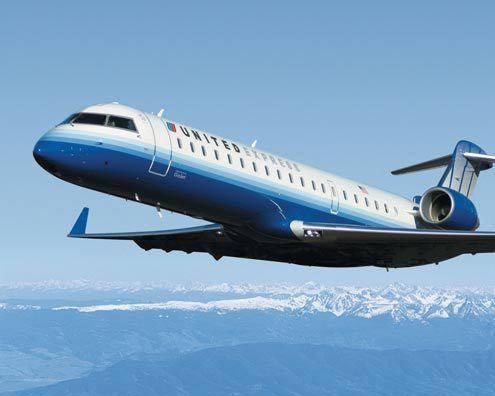
Development
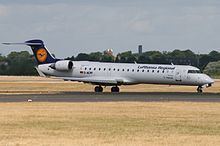
Following the success of the CRJ100/200 series, Bombardier produced larger variants in order to compete with larger regional aircraft such as Embraer's E-Jets, Fokker's F70/100 series, and the BAe 146/Avro RJ family.
CRJ700 series
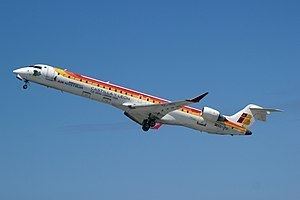
Design work on the CRJ700 by Bombardier started in 1995 and the programme was officially launched in January 1997. The CRJ700 is a stretched 70-seat derivative of the CRJ200. Seating ranges from 66 to 78 for the CRJ700 versions, however. The CRJ700 features a new wing with leading edge slats and a stretched and slightly widened fuselage, with a lowered floor.
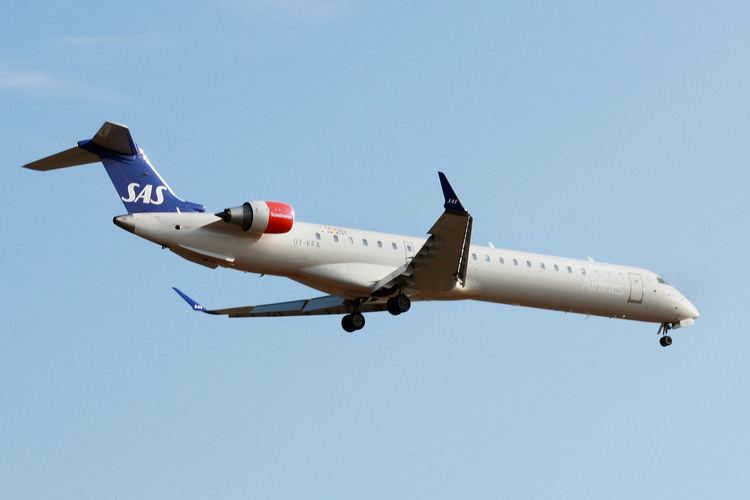
The early build aircraft were equipped with two General Electric CF34-8C1 engines. However, later build aircraft are now equipped standard with the -8C5 model, which is essentially an uprated 8C1. Most airlines have replaced the older engines with the newer model, while a few have kept the older -8C1 in their fleet. Maximum speed is Mach 0.85 (895 km/hr, 556 mi/hr) at a maximum altitude of 12,500 m (41,000 ft). Depending upon payload, the CRJ700 can travel up to 3,620 km (2,250 mi) with original engines, and a new variant with CF34-8C5 engines will be able to travel up to 4,660 km (2,900 mi).
The CRJ700 comes in three versions: Series 700, Series 701, and Series 702. The 700 is limited to 68 passengers, the 701 to 70 passengers, and the 702 to 78 passengers. The CRJ700 also has three fuel/weight options: standard, ER, and LR. The ER version has an increase in fuel capacity as well as maximum weight, which in turn increases the range. The LR increases those values further. The executive version is marketed as the Challenger 870.
Its first flight took place on 27 May 1999. The aircraft's FAA Type Certificate designation is the CL-600-2C10. The CRJ700 first entered commercial service with Brit Air in 2001. The CRJ700 directly competes with the Embraer 170, which typically seats 70 passengers.
In 2006, the CRJ700 was featured in Microsoft Flight Simulator X as one of the demo aircraft.
In 2008, the CRJ700 was replaced with the CRJ700 NextGen, featuring improved economics and a revised cabin common to the CRJ900 NextGen and CRJ1000 NextGen. In January 2011, SkyWest Airlines ordered four CRJ700 NextGen aircraft.
In 2016, Bombardier began offering a modernized cabin design for the CRJ Series with a more spacious entry, larger overhead bins, larger windows, newer seats, larger lavatories, and upgraded lighting.
CRJ900 and derivative
The CRJ900 is a stretched 76–90 seat version of the CRJ700. The aircraft features two GE CF34-8C5 engines, 59.4 kN (13,400 lbf) thrust with APR, and added leading edge slats. Its maximum ground takeoff weight is 84,500 pounds. The airplane is loosely based on the CRJ200 series with a few major improvements. The environmental packs have a target temperature instead of a hot-cold knob. The cabin has a recirculation fan which aids in cooling and heating. The engines are controlled by FADEC digital engine control instead of control cables and a fuel control unit. The cabin floor has been lowered 2 inches which gains outward visibility from the windows in the cabin as the windows become closer to eye level height. The APU is a Honeywell RE220 unit which supplies much more air to the AC packs and has higher limits for starting and altitude usage. The wingspan is longer, the tail is redesigned with more span and anhedral. In typical service the CRJ900 can cruise 8–10,000 ft higher with a slightly higher fuel burn and an average true airspeed of 450–500 knots, a significant improvement over its predecessor. The FAA Type Certificate designation of the CRJ900 is the CL-600-2D24.
The first CRJ900 (C-FRJX) was modified from the prototype CRJ700 by adding longer fuselage plugs fore and aft of the wings; it was later converted into the prototype CRJ1000 by installing longer fuselage plugs. The CRJ900 competes with the Embraer 175, and is more efficient per seat-mile, according to Bombardier. Mesa Air Group was the launch customer for the CRJ900 painted in America West livery.
In 2007, Bombardier launched the CRJ900 NextGen to replace the initial version. The new model has improved economics and a new cabin common to the CRJ700 NextGen and CRJ1000 NextGen. Mesaba Aviation, operating at the time as Northwest Airlink (now Delta Connection), was the launch customer, and remains the largest operator of the CRJ900 NextGen. The Mesaba fleet of CRJ900 NextGen aircraft are configured in a two class seating configuration, with 12 first class seats and 64 coach seats.
Comair, operating as Delta Connection, has ordered 14 CRJ900s, with at least 6 in service as of November 2007. These are in a two class configuration, with 12 first class seats and 64 coach seats. This is due to a limitation in Delta's contract with its pilots which limits its regional carriers to flying 76-seat aircraft.
In September 2011, PLUNA received its eleventh airplane (from an eventual total order of 15 with options). Estonian Air ordered 3 CRJ900 NextGen 88-seat aircraft. Also, SAS ordered 13 of these in March 2008. Iraqi Airways has ordered six Bombardier CRJ900 NextGen airliners and options on a further four of the type. In June 2010, Lufthansa ordered eight CRJ900 NextGen. In December 2012, Delta Air Lines ordered 40 CRJ900 NextGen worth $1.89 billion with 30 options.
The CRJ700 Series 705 is based on the CRJ900, with a business class cabin and a reduced maximum seating capacity to allow operation with regional airlines. The Series 705 seats 75 passengers. Some regional airlines have contracts with their major airlines that limit the maximum passenger capacity of aircraft they operate. The Air Canada Pilots Association negotiated a scope agreement with Air Canada limiting the maximum seating capacity of any jet aircraft at Air Canada Express to 75 seats. Air Canada Jazz was the launch customer for this aircraft in 2005 with 10 Executive Class and 65 Economy Class seats, all fitted with personal audio/video-on-demand systems. The FAA Type Certificate designation of the CRJ705 is the CL-600-2D15. Jazz Aviation, a subsidiary of Chorus Aviation, operates 16 CRJ705s on behalf of Air Canada and is currently the only operator of this version. On April 26, 2016, Jazz Aviation announced that existing CRJ705 aircraft in operation will be converted to CRJ900 standards.
In 2016, Bombardier began offering a modernized cabin design for the CRJ Series with a more spacious entry, larger overhead bins, larger windows, newer seats, larger lavatories, and upgraded lighting.
CRJ1000
On 19 February 2007, Bombardier launched the development of the CRJ1000, previously designated CRJ900X, as a stretched CRJ900, with up to 100 seats. Bombardier states that it offers better performance and a higher profit per seat than the competing Embraer E-190.
Brit Air and Air Nostrum were the launch customers for the CRJ1000. MyAir had ordered 15 CRJ900Xs that were converted to the CRJ1000, but the airline went bankrupt in July 2009. Atlasjet also indicated interest in the new type. On 14 June 2009 Bombardier announced a new firm order for 15 CRJ1000 NextGen aircraft placed by Air Nostrum, for a total of 35 CRJ1000 NextGen aircraft.
The CRJ1000 completed its first production flight on 28 July 2009 in Montreal; the entry into service was planned then for the first quarter of 2010. A month after the first flight, however, a fault in the rudder controls forced the flight-test program to be grounded. The program was not resumed until February 2010, and deliveries were projected to begin by January 2011.
Bombardier Aerospace announced on 10 November 2010 that its 100-seat CRJ1000 was awarded Aircraft Type Certificates from Transport Canada and European Aviation Safety Agency, allowing for deliveries to begin. On 14 December 2010, Bombardier began CRJ1000 deliveries to Brit Air and Air Nostrum. On 23 December 2010, it was announced that the Federal Aviation Administration had also awarded a type certificate, allowing the CRJ1000 to operate in US airspace. The FAA Type Certificate designation of the CRJ1000 is the CL-600-2E25. In February 2012, Garuda Indonesia ordered six CRJ1000s and took options for another 18, and Danish lessor Nordic Aviation Capital ordered 12 for Garuda to operate with delivery beginning in 2012. As of December 2015, a total of 43 aircraft had been delivered to airlines while there are 25 unfilled orders.
In 2016, Bombardier began offering a modernized cabin design for the CRJ Series with a more spacious entry, larger overhead bins, larger windows, newer seats, larger lavatories, and upgraded lighting.
Operators
As of July 2015, 317 CRJ700 aircraft (all variants), 339 CRJ900 aircraft (all variants) and 40 CRJ1000 aircraft were in airline service with SkyWest Airlines (132), Endeavor Air (81), Mesa Airlines (78), ExpressJet Airlines (71), GoJet Airlines (50), PSA Airlines (48), Envoy Air (43), HOP! (27), Air Nostrum (21), China Express Airlines (18), Lufthansa CityLine (18), Germanwings (17), Air Canada Express (16), Garuda Indonesia (15), Scandinavian Airlines (12), and other operators with fewer aircraft of the type.
Orders and deliveries
Bombardier data as of 31 December 2016.
Specifications
Source: Bombardier
